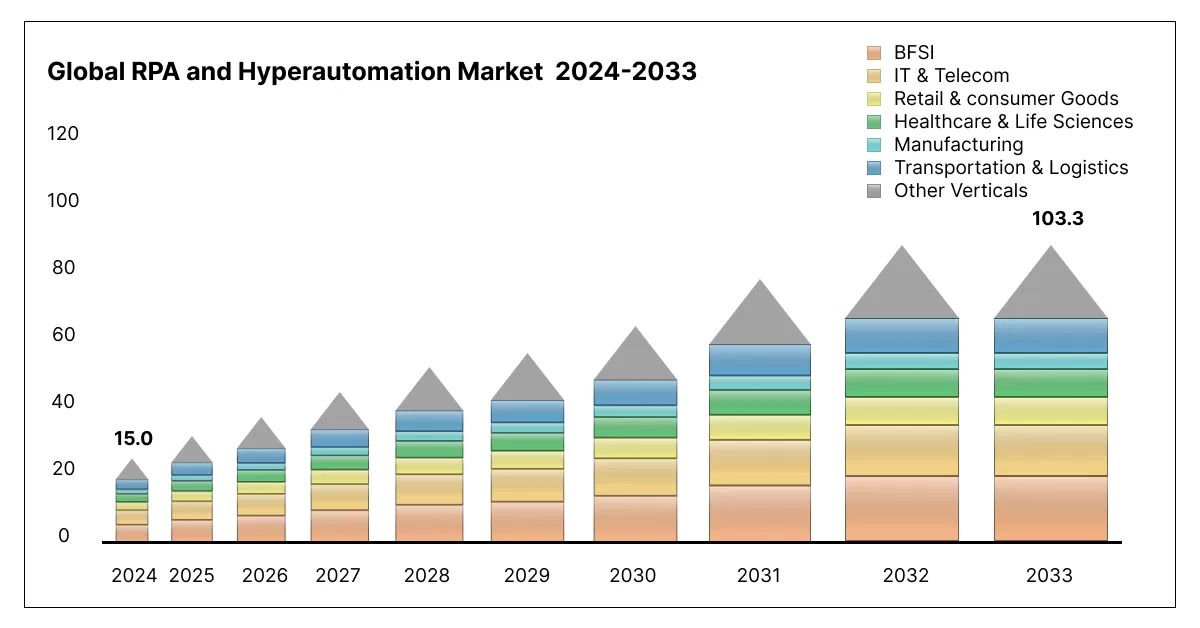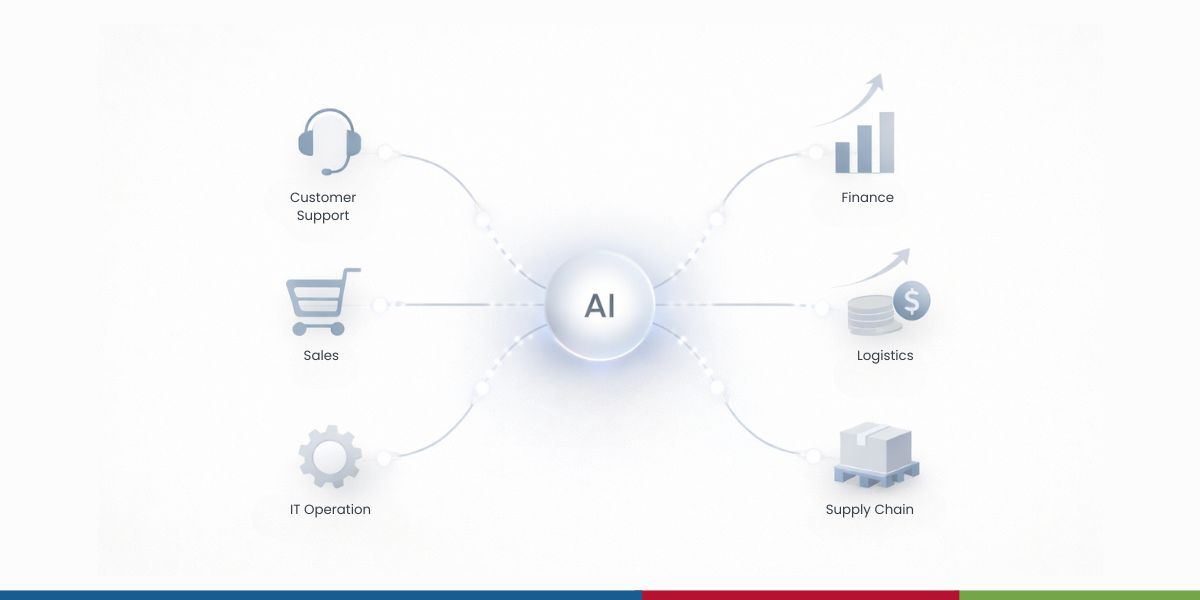RPA & Hyperautomation Market Size in 2025: A Detailed Report

4 min read | By Postpublisher P | 15 October 2024 | Robotics
How big is the RPA market projected to be by 2025?
“The RPA market is projected to reach $7.01 Bn by 2025”
Source: Gartner
Robotic Process Automation and Hyperautomation are the sure shot pillars of business transformation in 2025. These intelligent automation technologies are typically reshaping how organizations operate. With significant advancements in Artificial Intelligence (AI), Machine Learning (ML), and Analytics—the RPA and hyperautomation market will witness profound growth. This will help automate business workflows, giving businesses the competitive edge to stay relevant, save time and efforts while reducing costs. In this blog, let’s break down the top automation stats for 2025, and the positive impact it would have on productivity and results.
Robotic Process Automation & Hyperautomation Market
As competition continues to rise across sectors, businesses are looking for intelligent technologies to stay agile. RPA and hyperautomation is all set to stay in limelight in 2025 and years to come. New organizations are springing massively and it is only via adopting newer technologies can businesses sustain themselves with faster service and operations.
“The RPA and Hyperautomation market together is growing rapidly at a CAGR of 23.9% between 2024 and 2033.”
Source: Dimension Market Research
Technologies like RPA and hyperautomation make it easier for companies to acquire and deploy automated workflows and bot services which helps manage repetitive tasks, maximize efficiency, and stay more productive.
Why are Businesses Adopting Hyperautomation in 2025?
Several business processes that were previously people-centered now demand less human intervention due to the combined abilities of AI, robotics, and hyperautomation. The developmental strategies of companies today majorly involve leveraging intelligent technologies like RPA to improve performance across product, services, manufacturing, healthcare, and commerce sectors.
“According to NASSCOM, 80% companies would choose intelligent automation by 2025.”
Besides task automation, this trend majorly relies on infusing cognitive AI thinking into business processes. Natural Language Processing (NLP), predictive analytics, and more data-powered technologies are majorly adopted by companies to make better projections, and decisions with large volumes of data involved.
How do Intelligent Automation Platforms Help Reduce Costs?
One of the most important advantages of intelligent automation platforms that have in-built hyperautomation and RPA tools is its cost-efficiency. By helping companies automate repeated tasks, cut down time and resources for data analysis and decision making, these platforms significantly minimize the cost involved. The faster execution, improved accuracy, and fewer compliance risks combine to improve, resulting in better ROI over time. For businesses that aim to start small with automation, these platforms are highly beneficial.
10-Year Market Forecast (2024-2033)
The RPA and hyperautomation market is expected to continue its rapid growth over the next 10 years. While businesses continue to steadfast towards a tech-enabled ecosystem, stats from hyperautomation growth forecast through 2033 reveal a tremendous spike in adoption of this tech across industries.
Intelligent automation adoption in North America 2025
“North America is anticipated to have the largest market share of Robotic Process Automation & Hyperautomation dominance in the coming years.“
What’s driving hyperautomation growth across industries?
This scenario is also influenced by other factors such as digital agility, increasing digital transformation efforts, the need for operational efficiency, and advancements. Year-over-year, the growth is projected to be incremental with an estimated market value of $103.3 Bn between 2024 and 2033.

Factors such as economic conditions, technological advancements, and market adoption rates could impact the actual market growth. The global market is intently looking into RPA and hyperautomation adoption, leading to massive market expansion.
Factors Affecting Market Growth in 2025
Here’s how RPA will drive business efficiency this year.
1.Rising Need for Automation Across Industries
On an average, 50% of today’s work is automatable—businesses want to leverage the capabilities of Robotic Process Automation and Hyperautomation to achieve this possibility.
2.Companies Steering Towards Digital Transformation
The benefits of hyperautomation for enterprise transformation are many. And, as far as 2025 is considered, the industrial landscape is highly competitive and the need for intelligent technologies like RPA and hyperautomation are increasing like never before. For increased growth and revenue opportunities, businesses are highly opting to automate manual operation.
3.Focus on Cost Reduction
“A report by McKinsey highlighted that organizations implementing RPA solutions can save operational costs of up to 30%.”
Source: Dimension Market Research
Cost reduction is a crucial factor to a company’s spendings and ROI. And, the urge to reduce cost while maintaining quality and performance is what is influencing the market growth of RPA and hyperautomation. The cost-saving potential of automation may help companies yield bigger monetary results compared to previous years.
4.Risk Identification & Demand Forecasting
RPA and hyperautomation technologies are greatly helping businesses in identifying risks and project future trends more effectively, which has a direct impact on company results. This again is a key reason for increased RPA and hyperautomation market growth in 2025.
5.Enhanced Decision-making Capabilities
By automating data collection, analysis, and reporting with the means of AI, RPA, and hyperautomation, businesses can effectively make decisions that are crucial. Thus, increasing the market demand exponentially.
Best RPA tools adopted by businesses in 2025
As automation adaptability is spiking in 2025, businesses are steadily investing in RPA development and tools that advance the overall productivity and ROI. Built for intelligent workflows, these popular tools ease tasks, speed up processes, and improve results.
UiPath
Continues to dominate with its robust AI integration, process mining, and seamless automation across cloud and hybrid environments.
Automation Anywhere
Offers intuitive bot-building with advanced analytics and IQ Bot for document processing.
Blue Prism
Known for scalable digital workforce capabilities and strong governance, especially in large enterprises.
Microsoft Power Automate
Widely adopted for its integration with the Microsoft ecosystem and user-friendly flow automation.
NICE
Used predominantly in contact centers and back-office automation with AI decisioning and real-time process optimization.
WorkFusion
Popular for AI-driven automation and pre-built use cases in BFSI and healthcare sectors
What role does AI play in hyperautomation in 2025?
Is your business ready for AI-first automation in 2025? If not, read through! AI-powered automation is what will revolutionize the industrial landscape of the year. Artificial intelligence is the crux of today’s hyperautomation, and is powered by branches like machine learning, Natural Language Processing, computer vision, generative AI, and more.
- Make sure your techstack is AI compatible.
- Analyze if your business data is structured or unstructured.
- Is your team trained in handling AI systems for various workflows?
- Have you identified which process first demands automation?
These pointers will keep you AI ready before the actual implementation.
Highly Anticipated RPA & Hyperautomation Trends of 2025
Already using RPA? Discover the 2025 trends you can’t ignore!
The AI market is rapidly evolving and so are its storage, security, automation, thinking, and reasoning capabilities. In this section let’s discuss what the key trends in RPA and hyperautomation this year are.
Trend 1:
Intelligent Automation Systems
Automation is becoming smarter in 2025. The integration of technologies like Optical Character Recognition (OCR), machine learning, and RPA analytics into RPA systems is expected to eliminate desk interaction by 40% by 2025, according to IDC. This will lead to more efficient and accurate processes.
Trend 2:
Cloud Deployment
The cloud deployment segment is projected to continue dominating the market due to its advantages, such as lower costs, faster outcomes, and scalability.
Trend 3:
Intelligent Process Automation (IPA)
IPA enables bots to learn from experience and make autonomous decisions, enhancing their capabilities and adaptability.
Trend 4:
Process Discovery
Process discovery utilizes AI to uncover processes and automatically develop bots, streamlining the automation process for maximizing business efficiency.
What is the future of RPA and hyperautomation in 2025?
- Increased adoption of AI-powered RPA to handle more complex tasks and make intelligent decisions.
- Expansion of hyperautomation across different sectors.
- As RPA and hyperautomation become more prominent, ethical challenges will be addressed.
- RPA and hyperautomation will be integrated with ML, IoT, blockchain, and cloud computing for maximizing business efficiency.
- Continuous model and bot training custom to business uniqueness.
What to Look for in 2025?
In conclusion, RPA and hyperautomation are set to play a significant role in shaping the business landscape in 2025 and beyond. By leveraging these technologies, organizations can improve efficiency, reduce costs, and gain a competitive advantage.
The latest from our editors
Join over 150,000+ subscribers who get our best digital insights, strategies and tips delivered straight to their inbox.


